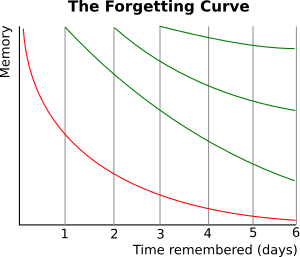Forgetting curve facts for kids
The forgetting curve is a cool idea from psychology that helps us understand how quickly we forget new information if we don't try to remember it. Imagine learning something new, like a list of words or facts for a test. The forgetting curve shows that you'll forget most of it pretty fast unless you review it!
This idea was first discovered by a German psychologist named Hermann Ebbinghaus. He also came up with the idea of strength of memory. This means that some memories are stronger than others, and stronger memories last longer in our minds.
Contents
What is the Forgetting Curve?
The forgetting curve is a graph that shows how much information we remember over time. It usually looks like a steep slope going down. This means we forget a lot right after learning, and then we forget less and less as time goes on.
How Ebbinghaus Discovered It
Hermann Ebbinghaus did an interesting experiment to find out how memory works. He used himself as the test subject! He tried to memorize lists of made-up words, like "WID" or "ZOF." These words were called "nonsense syllables" because they didn't mean anything. This helped him make sure he was only testing pure memory, not how much sense the words made.
Ebbinghaus tested himself over and over again after different amounts of time. He wrote down how much he remembered each time. He then put all his results on a graph. This graph became known as the "forgetting curve." His work was published in 1885 in a book called Über das Gedächtnis, which means "About Memory."
What the Curve Shows
The forgetting curve shows that we forget things very quickly at first. For example, Ebbinghaus found that after just 20 minutes, people might only remember about 60% of what they learned. After a whole week, they might only remember about 15%!
Later, in the 20th century, other researchers like Georg Elias Müller repeated Ebbinghaus's experiments. They got similar results, which means Ebbinghaus's findings are still considered very important and true today.
How to Remember Things Better
The good news is that you can fight the forgetting curve! Ebbinghaus's work showed that to remember things better, you need to review them.
The Power of Repetition
When you repeat or review information, you make your memory of it stronger. Think of it like building a muscle: the more you work it, the stronger it gets. The more you review something, the less likely you are to forget it.
Things you use or think about often are also much harder to forget. For example, you probably won't forget your own name or your best friend's name because you use them all the time! This is why studying a little bit every day for a test is much better than trying to cram everything the night before.
Related pages
- Learning curve
See also
 In Spanish: Curva del olvido para niños
In Spanish: Curva del olvido para niños


